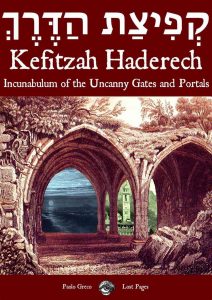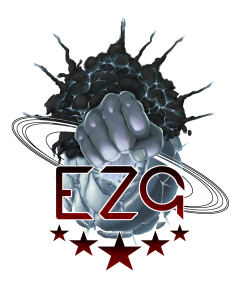Kefitzah Haderech – Incunabulum of the Uncanny Gates and Portals (OSR/almost system neutral)
Kefitzah Haderech – Incunabulum of the Uncanny Gates and Portals (OSR/almost system neutral)
This booklet clocks in at 32 pages, 1 page editorial/ToC, 1 page thank you note, leaving us with 30 pages of content, laid out in 6’’ by 9’’ (A5) – and yes, the pdf does not have the front and back cover as part of the pdf itself. I also own the PoD softcover, which is a stapled booklet. My review is based on both versions.
While this book is designated as OSR, it is actually almost system neutral – apart from singular references to SAVE or the sparse damage value here and there, the book is not limited to such games in its utility.
So, the pdf begins by explaining the Hebrew expression of “contracting the path/shortening the way” – which is a perfect way to think of portals and gates. The supplement then begins to talk about portals and gates in a game context: As a plot device, as a shortcut, and about their significance regarding connections – this might be me talking in a post-COVID-19-world, but after playing Death Stranding, I have actually a greater appreciation of using and not using portals as far as their significance.
The supplement then proceeds to talk about types of portals – one-way portals, coupled ones, hubs and portal nexus set-ups, and, of course, relays and portal groups. Particularly portal relays are criminally underrated as far as I’m concerned, so thinking in a methodic manner about the subject matter? Seriously helpful.
Beyond that, we take remote perception, as well as awareness of the portal and its accessibility into account. In short: We begin with a serious of considerations that helps the Gm think of the content herein in a structured manner.
The book then brings us to the portal itself and provides a d20 generator with three columns, which lets you determine portal frame, opening and extras – to give you an example, I got a frame of living flesh, with the opening consisting of psychedelic colors and which emits an alkali odor. Cool!
Portal keys are up next – they can be physical objects, non-physical concepts, or simply esoteric names – and once more, we get a d20-based generator with 4 relevant columns: I got an “Exegetic shibboleth of the unearthly peregrination.” Come on, that is cooler than just some portal key, right?
Of course, the construction of portals also requires some consideration, and the supplement suggest 5K gold and a week of work – this is what I’d suggest for OSR-games; for others, I’d adjust the price accordingly – unless you want some serious portal hopping. The section provides a d10 table of considerations pertaining to construction: Perhaps portals can only be erected on ley lines, or the mystic toponyms must be carved into the portal…but unfortunately, they also must be palindromes (have fun making your PCs deal with this…)…and what about the implication of requiring the bones of twins, shuffled and then separated? *shudder* Really neat ideas!
However, the main meat of the booklet is devoted to the massive PORTATRON, a gigantic portal openings generator. This generator consists of a d10-table “The Portal looks like…”, and 1d6 “…and you will find it” – Here, I got “A well or pit in the ground, which when opened is filled with mist, which will be found in a shrine, with an altar located in front of it. The next table has a promising header: “And do you remember when I told you it was safe? I lied because…” – this table has 17 entries, and is rolled on a d30; I got entry 6, which is: “IT BURRRNS!!! Take 3d6 fire damage, SAVE for half damage. Maybe due to lasers: PEW PEW PEW! Or RADIOACTIVITY!!!” There is a fun and often irreverent tone in some entries, but never to the extent where I found it intrusive. As you can see, while the book does have notes like “save” or “Save or die”, it is for the most part system neutral – the damage values and negative consequences for some portals lend themselves to old-school playing, but also represent one of my gripes: I don’t think that using a portal (unless it’s sabotaged/the PCs have botched something should be lethal; save or die is warranted when the players screwed up. So yeah, not a big fan of this aspect.
Next, we have a d12 table of “the Key is…” – most of these have 6 to 8 subentries, which then might have more subsections. In my sample run, I got “An action, which must be carried out in front of the portal”;subentry + sub-section: the password must be sung.” The key in my test-run was related to ( a d4-table)…nothing specific. After that, we get a 10-entry d20-table to determine why the key’s special. Here, I got that the key can open d6-in-6 portals, but always one-way and towards the same destination.
And then, we have the largest table herein – a massive d666 table. The tongue-in-cheek “you end up in R’lyeh”-entry can be found, but is certainly not representative: The PCs might end up in a fortress of petrified soldiers, actually a child’s toy, or in a jungle in a huge impact crater, where a osmium-iridium meteorite is constantly seeping oozes. My test-run delivered the following entry: “ The study of the great sorceress Edonoplechtus VI; 1-in-6 she’s here researching some crossbreed monsters; else she just left all her pets here. Now yo have a good excuse to unleash the lobstegasuaruses, crocodingoes, ducksharks and roosturgeons you found in that monster manual.” I loved this one. It made me stat up a lobstegasaurus. This table, btw.? Its entries are massive – 12 pages of destinations!
The final pages of the supplement are essentially a portal-relevant appendix N, with each entry properly explained and contextualized, from Ultima Underworld II to Planescape, Portal, Dr. Who, Stargate, etc.
Conclusion:
Editing and formatting re very good ona formal and rules-language level. Layout adheres to a one-column b/w-standard with minimum frills, and the supplement features tastefully-chosen public domain art. The pdf annoyingly has no bookmarks, which makes using it a colossal pain – I’d recommend print over pdf here…also because this is a book that you can use time and again.
Paolo Greco’s portal booklet is one of these nifty GM-evergreens that you can use time and again. The book starts off with some handy considerations when it comes to thinking about portals, and then provides this ginormous, quick to use and incredibly diverse generator. If I have any valid complaints against this, then that’d be that I’d have loved to see it subscribe to a proper system for adequate pricing of portal construction, or to go full-blown system neutral. That, and the few save or sucks, which are simply not that helpful in a book about random portal generation.
That being said, the playful tone that never became obtrusive, the sheer imagination here, and the fact that this covers a topic only scarcely touched in such detail certainly makes this one of the handy booklets I’ve been using time and again. For the pdf version and its diminished utility, you might want to subtract a star, but my gripes notwithstanding, I’d be a colossal hypocrite if I rated this anything but 5 stars + seal of approval – I’m using this too often, and have too much fun doing so, to rate this any other way. If you want to make your portals more diverse, esoteric and strange, look no further.
You can get this book here on OBS!
The print-version can be found here!
If you can, I’d appreciate any support you can show by sharing, donating, or joining my patreon. Thank you!
Endzeitgeist out.



Interesting tidbit: There is a small similarity to the name of the prophet in Dune: Kwisatz Haderach
No wonder – the name implies the concept of “contracting the path/canceling distance”, which is perfect for Dune, right? 😀